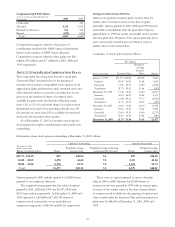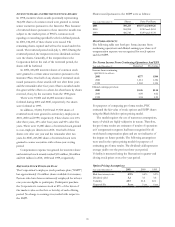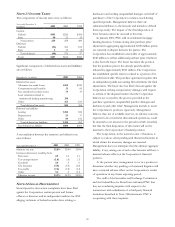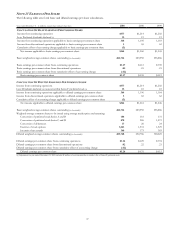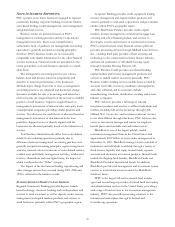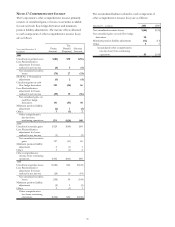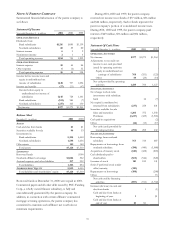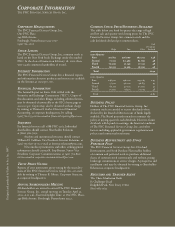PNC Bank 2001 Annual Report Download - page 93
Download and view the complete annual report
Please find page 93 of the 2001 PNC Bank annual report below. You can navigate through the pages in the report by either clicking on the pages listed below, or by using the keyword search tool below to find specific information within the annual report.
91
NOTE 28 FAIR VALUE OF FINANCIAL INSTRUMENTS
2001 2000
December 31 - in millions
Carrying
Amount
Fair
Value
Carrying
Amount
Fair
Value
Assets
Cash and short-term assets $6,200 $6,200 $5,041 $5,041
Securities 13,908 13,905 5,902 5,902
Loans held for sale 4,189 4,189 1,655 1,655
Net loans (excludes leases) 32,941 33,588 46,066 46,872
Commercial mortgage servicing rights 199 240 156 267
Financial derivatives (a)
Interest rate risk management 278 278
Commercial mortgage banking risk management 55
Customer/other derivatives 497 497
Liabilities
Demand, savings and money market deposits 34,531 34,531 30,686 30,686
Time deposits 12,773 12,942 16,978 17,101
Borrowed funds 12,390 12,677 11,822 12,043
Financial derivatives (a)
Interest rate risk management 16 16
Commercial mortgage banking risk management 44
Customer/other derivatives 476 476
Off-Balance-Sheet
Unfunded loan commitments (12) (12) (11) (11)
Letters of credit (10) (10) (10) (10)
Financial derivatives (a)
Interest rate risk management 63 104
Commercial mortgage banking risk management (2) (10)
Credit-related activities (b) (2)
(a) Effective January 1, 2001, the Corporation implemented SFAS No. 133. The statement requires the Corporation to recognize all derivative instruments as either assets or liabilities
on the balance sheet at fair value. Financial derivatives are reported at fair value in other assets or other liabilities.
(b) Due to the structure of these contracts, they are no longer considered financial derivatives under SFAS No. 133.
Real and personal property, lease financing, loan customer
relationships, deposit customer intangibles, retail branch
networks, fee-based businesses, such as asset management
and brokerage, trademarks and brand names are excluded
from the amounts set forth in the previous table.
Accordingly, the aggregate fair value amounts presented do
not represent the underlying value of the Corporation.
Fair value is defined as the estimated amount at which a
financial instrument could be exchanged in a current
transaction between willing parties, or other than in a forced
or liquidation sale. However, it is not management’s
intention to immediately dispose of a significant portion of
such financial instruments, and unrealized gains or losses
should not be interpreted as a forecast of future earnings and
cash flows. The derived fair values are subjective in nature,
involve uncertainties and significant judgment and, therefore,
cannot be determined with precision. Changes in
assumptions could significantly impact the derived fair value
estimates.
The following methods and assumptions were used in
estimating fair value amounts for financial instruments.
GENERAL
For short-term financial instruments realizable in three
months or less, the carrying amount reported in the
consolidated balance sheet approximates fair value. Unless
otherwise stated, the rates used in discounted cash flow
analyses are based on market yield curves.
CASH AND SHORT-TERM ASSETS
The carrying amounts reported in the consolidated balance
sheet for cash and short-term investments approximate fair
values primarily due to their short-term nature. For purposes
of this disclosure only, short-term assets include due from
banks, interest-earning deposits with banks, federal funds
sold and resale agreements, trading securities, customer’s
acceptance liability and accrued interest receivable.
SECURITIES
The fair value of securities is based on quoted market prices,
where available. If quoted market prices are not available, fair
value is estimated using the quoted market prices of
comparable instruments.





